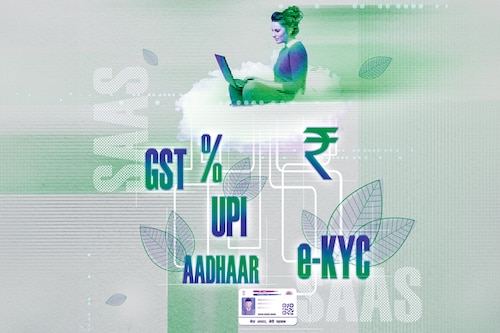It's time for consolidation in fintech SaaS: Bala Srinivasa
A multi-decade investing spree in SaaS has created a vast and fertile field of roll-up opportunities globally, the managing director of Arkam Ventures, an early stage VC firm, writes



India’s financial services sector has undergone massive transformation over the past two decades. Digitalisation has been the main driver as businesses and consumer expectations changed in the wake of Aadhaar, e-KYC, UPI and GST adoption. It’s not a stretch to say that every financial transaction flow has seen modification or is in the process of being transformed.
Think of payments, loans, investing, bank transfers, real estate registrations and taxes, just to scratch the surface. For India’s incumbent banks and financial services companies, digitalisation became a top priority with massive budget allocations.
Providing the picks and shovels in a gold rush is always a big opportunity. What started as a small band of banking tech startups morphed into a wave of B2B (business-to-business) fintech SaaS (software as a service) providers. There are over 150 funded fintech SaaS companies in India. According to data provider Tracxn, these companies have collectively raised over $2 billion in funding with a combined market value of $9 billion.
After decades of archaic systems, banks suddenly have a choice of third-party options for almost any core process—core banking, lending management systems, risk management, onboarding, compliance, treasury, customer management, just to name a few.
The big fintech theme of a decade ago was “unbundling". How software companies could disrupt specific high-value financial services processes and become market leaders in a chosen vertical. The question for India’s B2B fintech market has been if it’s big enough to support the emergence of several large standalone software providers.
It’s clear that B2B fintech SaaS in India is entering its best era in terms of customer spend. We should see a few companies get to a $50-100 million ARR (annual recurring revenue) on a standalone basis. But as more and more SaaS companies emerge, servicing a limited number of large customers, it’s hard to see how most of them can scale independently.
There is a compelling case for value creation via acquisitions and a smart roll-up strategy.
The software market pendulum has always swung between best-of-breed and integrated providers. A decade ago, every new fintech SaaS player with a meaningful solution was able to kick off a pilot and attract interest at banks. Today, CIOs and CTOs with large budgets have a lot more on their plate in terms of new technology shifts, especially around generative artificial intelligence (AI).
If you zoom out, there is a prevailing trend of SaaS roll-ups across the world and across industries as investors grapple with a lack of critical mass. The multi-decade investing spree in SaaS has created a vast and fertile field of roll-up opportunities globally.
According to data provider Pitchbook, large PE shops like Thoma Bravo and Vista Equity Partners are the biggest owners of SaaS today with each of them having over $20 billion in earned software income. For PE funds, software has become their main go-to category for a reason: SaaS companies bring high margins, recurring revenue, multi-year contracts, and the opportunity to create leverage from a larger footprint.
Perfios’s magical run may be the first indication of this opportunity in India. Despite being one of the pioneers (founded in 2007) in the Indian B2B fintech scene, growth was slow for Perfios, well into 2019 (~₹43 crore/$5 million ARR). However, the company had amassed a blue-chip customer base of the largest Indian banks for its credit decisioning and analytics solution.
The post-Covid digitalisation growth along with the roll-up strategy decision led by Warburg Pincus has completely transformed the company. Perfios acquired Karza (onboarding and fraud prevention) for $80 million in 2022. Since then, the combined company has tripled its revenue from ₹139 crore ($17 million ARR) to ₹407 crore ($50 million ARR) in 2023.
Along the way, the company turned Ebitda positive. Investors have pumped in $450 million since 2019, and an investment by OTTP in 2024 pushed valuation into unicorn status.
With this war chest, it’s clear that Perfios will continue to make acquisitions while assembling one of the larger new-age fintech SaaS product suites for banks and financial services firms. Over the next 18 months, Perfios plans to get to $100 million ARR and an India IPO listing.
Fintech SaaS startups have multiple options but need to choose wisely. Roll-ups can have a serious impact on prevailing competitive dynamics. There are over 50 B2B fintech SaaS startups in the $2-10 million ARR range. All of them have duplicate sales, marketing, customer success and product teams servicing a few hundred large-enterprise customers.
The right roll-up creates a new combined entity with significant leverage in terms of size, capital and operational efficiencies.
The entity can accelerate growth with better cross-sell and a more efficient sales structure. It also benefits from better pricing power versus smaller competitors. So, while integrating acquisitions is never easy, successful roll-ups see significant cost efficiency.
Winds of consolidation add another layer of opportunity as well as risk. As a founder or a management team, it’s well worth scenario planning possible roll-ups and their impact on the business. For example, should you be the consolidator or become part of a roll-up? Or should you hold course?
A lot of these answers are segment-specific. In maturing market segments, the best niche product may no longer have enough headroom to scale or the muscle to compete with a much larger player.
Young, India-focussed fintech B2B SaaS companies are in a great place with a lot to look forward to. There will absolutely be a handful of market leaders that build large, standalone companies on rapid organic growth. However, the market has also evolved to now offer a competing narrative of roll-ups that create large outcomes.
This is what Perfios has demonstrated, and other investor-funded combinations are likely not far behind.
First Published: May 21, 2024, 15:32
Subscribe Now